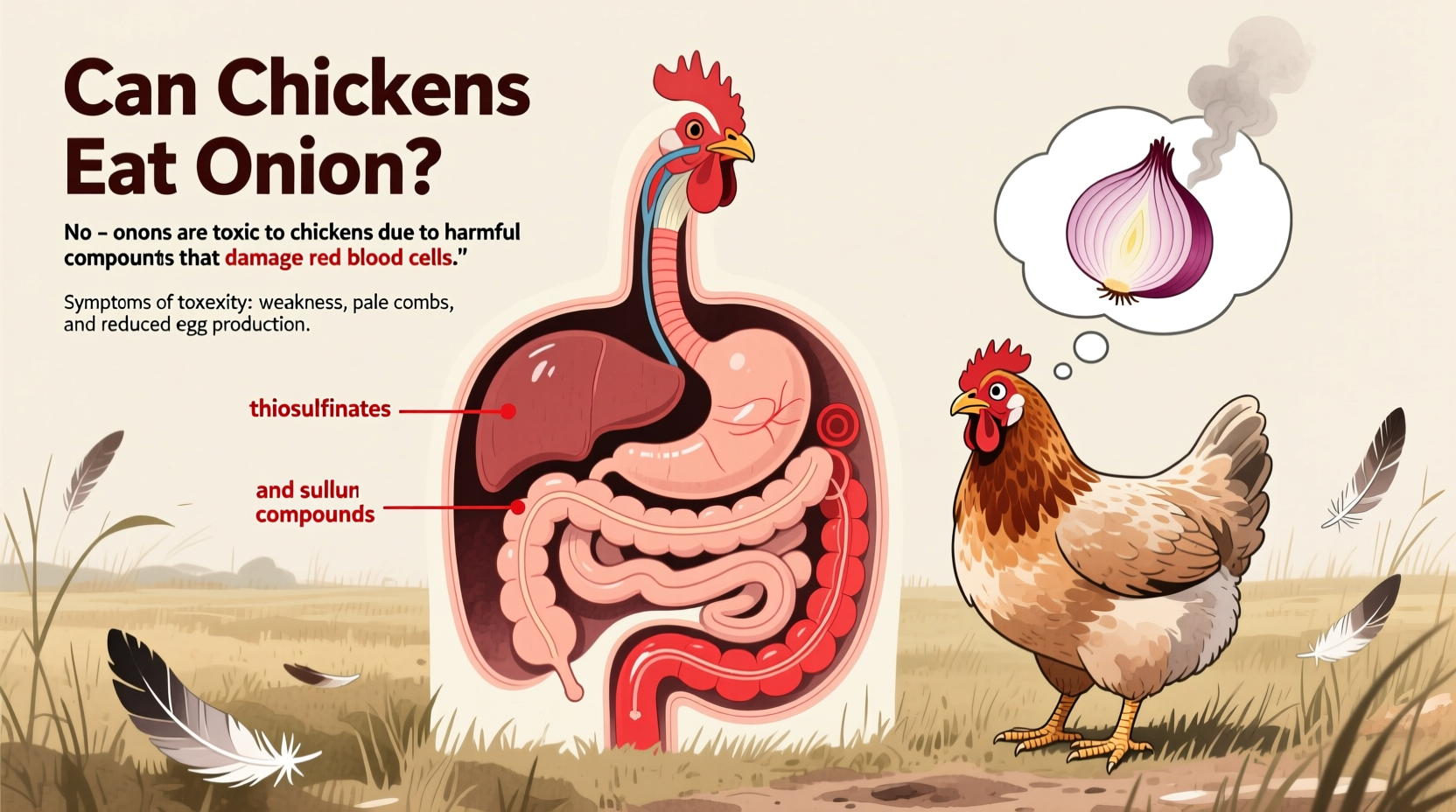As a backyard chicken keeper, you want the best for your flock. Understanding what foods are safe is crucial for their health and productivity. Let's explore why onions pose such a serious risk and what you can safely feed your chickens instead.
Why Onions Are Dangerous for Chickens
Onions belong to the Allium family, which includes garlic, leeks, and chives—all harmful to chickens. The toxic component, thiosulphate, oxidizes hemoglobin in red blood cells, causing them to rupture. This condition, known as hemolytic anemia, reduces oxygen delivery throughout the body.
Unlike humans, chickens lack the enzyme necessary to break down thiosulphate safely. Research from the Penn State Extension confirms that poultry cannot metabolize these compounds effectively, making even small exposures potentially dangerous.

Symptoms of Onion Toxicity in Chickens
Recognizing early signs of onion poisoning can save your chicken's life. Symptoms typically appear 24-72 hours after ingestion and include:
- Pale combs and wattles (normally bright red)
- Weakness and lethargy
- Reduced egg production
- Labored breathing
- Dark-colored urine
- Loss of appetite
Severe cases can lead to collapse, organ failure, and death. The Merck Veterinary Manual notes that hemolytic anemia in poultry requires immediate veterinary attention as there's no specific antidote—only supportive care.
Onion Exposure: What to Do Immediately
If you discover your chickens have eaten onions, take these steps:
- Remove all onion sources from their environment
- Provide fresh water with electrolytes to support hydration
- Monitor closely for symptoms over the next 72 hours
- Contact a poultry veterinarian immediately if symptoms appear
Do not induce vomiting—chickens have a different digestive system than mammals. Early intervention significantly improves recovery chances.
| Food Item | Safe for Chickens? | Notes |
|---|---|---|
| Onions (raw/cooked) | No | All forms toxic; causes hemolytic anemia |
| Garlic | Minimal amounts only | Small quantities may boost immunity; large amounts toxic |
| Leeks/Chives | No | Same toxic compounds as onions |
| Green onion tops | No | Still contain harmful compounds |
| Celery | Yes | Excellent treat in moderation |
Safe and Nutritious Alternatives to Onions
Instead of onions, offer these healthy treats that provide nutritional benefits without the risks:
- Leafy greens (kale, spinach, lettuce) - rich in vitamins A and K
- Vegetable scraps (carrot tops, cucumber slices, zucchini)
- Fruits (berries, melon, apple slices - remove seeds)
- Herbs (parsley, cilantro, mint) - natural digestive aids
- Mealworms - excellent protein source
The Purdue University Poultry Extension recommends that treats should comprise no more than 10% of a chicken's diet, with quality layer feed providing the essential nutrients they need.
Preventing Onion Exposure in Your Flock
Prevention is always better than treatment. Implement these strategies:
- Store kitchen scraps securely away from chicken access
- Compost onion waste in sealed containers
- Educate family members about toxic foods for chickens
- Supervise chickens when gardening or during yard cleanups
- Create physical barriers between garden areas and chicken runs
Remember that chickens are natural foragers and will investigate anything new in their environment. The University of Georgia Extension emphasizes that consistent management practices significantly reduce accidental poisoning risks.
Understanding the Risk Timeline
Many chicken owners mistakenly believe that small amounts of onions are harmless. However, research shows the toxin accumulates in the system. Here's what happens after ingestion:
- 0-12 hours: No visible symptoms (toxin begins damaging red blood cells)
- 12-48 hours: Early symptoms appear (pale combs, lethargy)
- 48-72 hours: Peak toxicity (severe anemia, respiratory distress)
- 72+ hours: Recovery or complications (depending on exposure level and treatment)
This delayed reaction means you might not connect your chicken's illness with onion consumption that happened days earlier. The American Veterinary Medical Association stresses that early detection dramatically improves outcomes for poultry poisoning cases.
Common Misconceptions About Onions and Chickens
Several myths persist in backyard chicken communities:
- "Cooked onions are safe" - Cooking doesn't destroy thiosulphate
- "Small amounts boost immunity" - Unlike garlic, onions provide no health benefits
- "My chickens ate onions and were fine" - Effects may be delayed or subtle (reduced egg production)
- "Organic onions are safe" - Toxicity comes from natural compounds, not pesticides
These misconceptions often come from well-meaning but misinformed backyard chicken forums. Always verify feeding advice with veterinary or agricultural extension sources rather than anecdotal evidence.
When to Consult a Poultry Veterinarian
Don't wait for severe symptoms to appear. Contact a vet if:
- You know your chickens consumed onions
- You notice any pale combs or wattles
- Egg production drops suddenly
- Chickens seem unusually lethargic
Early intervention might include fluid therapy, supplemental oxygen, and blood tests to monitor red blood cell counts. The American Association of Avian Pathologists recommends finding a vet experienced with poultry before emergencies occur.
Building a Safe Treat Routine for Your Flock
Instead of risky human foods, establish a safe treat routine:
- Create a weekly treat schedule (e.g., vegetable scraps on Tuesdays and Fridays)
- Introduce new foods gradually in small quantities
- Keep a food diary to track reactions
- Use treats for training and bonding
- Always provide fresh water with treats
This structured approach prevents overfeeding and helps you quickly identify any problematic foods. Remember that chickens thrive on routine and consistency in their diet.











 浙公网安备
33010002000092号
浙公网安备
33010002000092号 浙B2-20120091-4
浙B2-20120091-4